Your cart is currently empty!
Tag: Japanese grammar
-
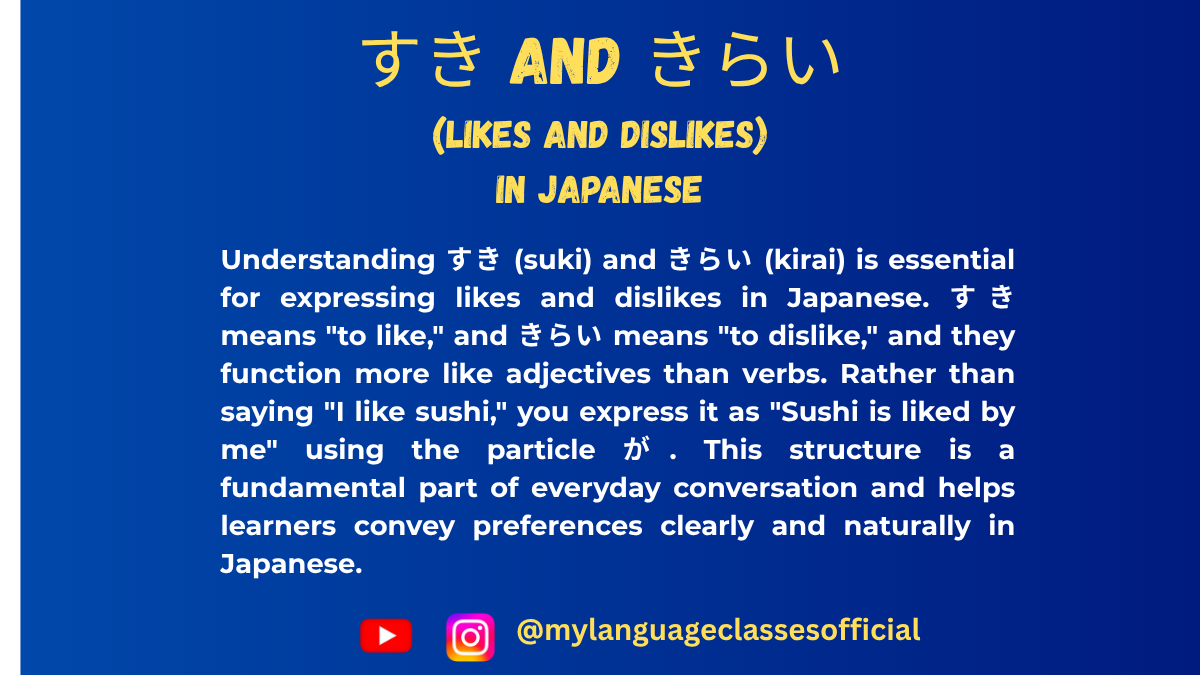
Expressing Likes and Dislikes すき and きらい in Japanese | My Language Classes
Likes and Dislikes in Japanese
こんにちは!(Konnichiwa!)
Learning how to express preferences is one of the most useful and fun parts of mastering Japanese. Today, let’s dive into two essential words: 好き (すき) for “like” and 嫌い (きらい) for “dislike.” Not only will we explore their meanings, but also how to use them naturally in sentences.
1. 好き (すき) – To Like
How to Use 好き
The word 好き means “like” or “fond of” and is commonly used to express your preferences. The structure is simple:
Noun + が好き
This translates to “I like [noun].”Examples:
- 日本語が好きです。
Nihongo ga suki desu.
I like Japanese.- Here, 日本語 (Nihongo) means “Japanese,” and が marks it as the topic you like. Adding です makes it polite.
- 犬が好き。
Inu ga suki.
I like dogs.- This informal version is common among friends or in casual settings.
Expressing Love or Passionate Likes
To emphasize your love or deep passion for something, you can use 大好き (だいすき/daisuki):
- チョコレートが大好きです!
Chokorēto ga daisuki desu!
I love chocolate!
2. 嫌い (きらい) – To Dislike
How to Use 嫌い
On the flip side, 嫌い means “dislike” or “hate.” The structure is the same as 好き:
Noun + が嫌い
This means “I dislike [noun].”Examples:
- ピザが嫌いです。
Piza ga kirai desu.
I dislike pizza.- ピザ (Piza) means “pizza.” While it’s a popular dish, some people might find it too greasy!
- 虫が嫌い。
Mushi ga kirai.
I hate insects.- 虫 (Mushi) refers to “insects.” Use this informal structure with friends.
Expressing Strong Dislike
If you strongly dislike something, you can say 大嫌い (だいきらい/daikirai):
- 雨が大嫌いです!
Ame ga daikirai desu!
I hate rain!
3. Cultural Notes
- “Softer Tone for Dislikes”: In Japanese culture, direct expressions of dislike like 嫌い might come off as too strong in some situations. To soften it, you can use phrases like:
- あまり好きじゃない (Amari suki janai) – “I don’t really like [it].”
- ちょっと苦手です (Chotto nigate desu) – “I’m a bit bad with [it].”
- Overuse of 好き: While 好き is positive, saying it too often might sound insincere. Balance your expressions to match the context.
4. Grammar and Nuance Tips
- No Verb Needed:
Both 好き and 嫌い function as な-adjectives, not verbs. This means they don’t need any conjugation or additional verbs to form basic sentences.Example:- Correct: 猫が好きです。 (Neko ga suki desu. – “I like cats.”)
- Incorrect: 猫が好きをです。 (Neko ga suki wo desu. – This is ungrammatical.)
- が (Ga) vs. は (Wa):
Although が is standard for these structures, は can be used for contrast or emphasis:- 犬は好きですが、猫は嫌いです。
Inu wa suki desu ga, neko wa kirai desu.
I like dogs, but I dislike cats.
- 犬は好きですが、猫は嫌いです。
5. Practice Time!
Let’s put what you’ve learned into action. Try completing these sentences:
- 私は ______ が好きです。
(Watashi wa ______ ga suki desu.)- Translate: “I like ______.”
- 友達は ______ が嫌いです。
(Tomodachi wa ______ ga kirai desu.)- Translate: “My friend dislikes ______.”
- ______ は大好きです!
(______ wa daisuki desu!)- Translate: “I love ______!”
6. Wrap-Up
Now you can confidently express what you like and dislike in Japanese! Start practicing by talking about your favorite foods, hobbies, and activities. Try to notice how native speakers use 好き and 嫌い in conversations—it will deepen your understanding.
If you have questions or want to share your sentences, feel free to leave a comment below!
それでは、またね!(Soredewa, matane!)If you enjoyed this lesson, be sure to check out more posts like this on my blog at My Language Classes. Don’t forget to subscribe my YouTube channel and follow me on Instagram for the latest language learning tips and lessons. Leave a comment below to share your thoughts, or ask any questions you have about nouns.
Happy learning! 😊
- 日本語が好きです。
-
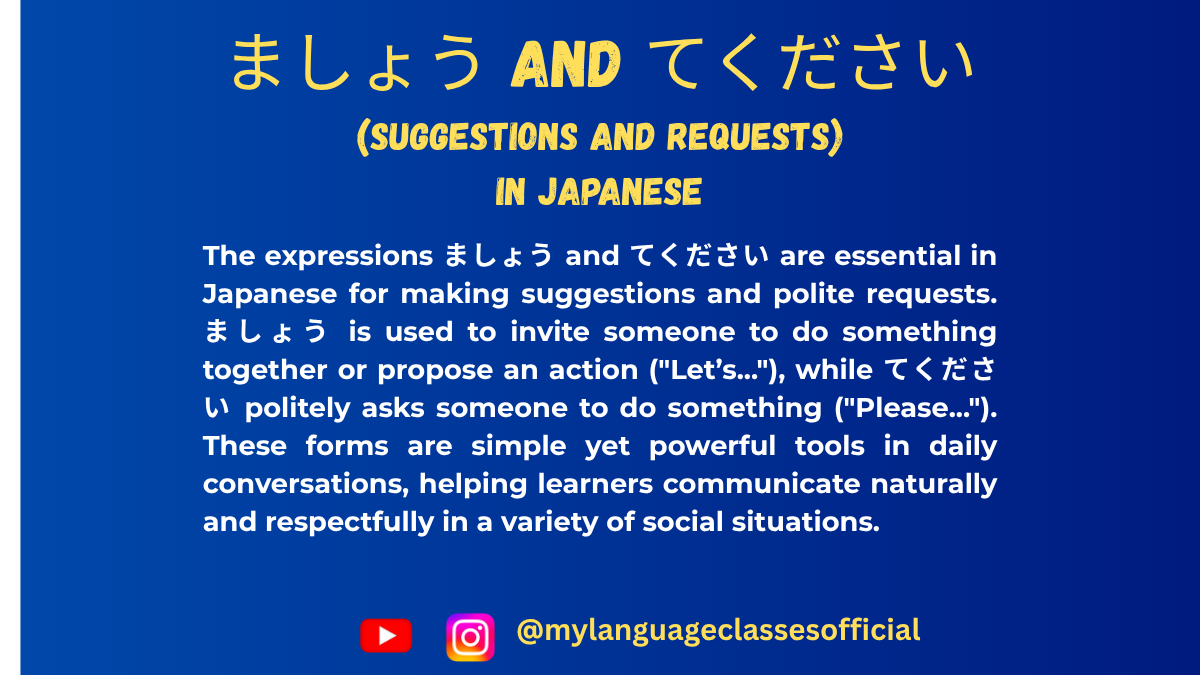
Making Suggestions and Polite Requests ましょう and てください in Japanese | My Language Classes
Mastering Polite Suggestions and Requests in Japanese
If you’re learning Japanese, understanding how to make polite suggestions and requests is a key part of effective communication. Whether you’re planning activities with friends or politely asking for help, two common expressions—Verb stem + ましょう and Verb stem + てください—are your go-to tools. Let’s dive into their usage, including how to form them step by step.
1. Making Suggestions with ましょう (mashou): “Let’s [verb]”
The expression ましょう is a polite and versatile way to suggest an activity or propose an idea. It carries a collaborative tone, meaning “Let’s do [verb].”
How to Form the ましょう Form
Japanese verbs are divided into three groups, and the method for creating the ましょう form depends on the group.
Group 1: U-Verbs (Godan Verbs)
- Start with the stem of the verb (remove the u-ending).
- Replace the u sound with the i sound.
- Add ましょう.
Verb Stem Change to i Form Add ましょう Example Translation 行く 行 行き 行きましょう Let’s go. 書く 書 書き 書きましょう Let’s write. 話す 話 話し 話しましょう Let’s talk.
Group 2: Ru-Verbs (Ichidan Verbs)
- Remove the final る.
- Add ましょう.
Verb Stem Add ましょう Example Translation 食べる 食べ 食べましょう Let’s eat. 見る 見 見ましょう Let’s look.
Group 3: Irregular Verbs
There are two irregular verbs, and their ましょう forms are as follows:
Verb Change to Stem Add ましょう Example Translation する し しましょう Let’s do it. 来る (kuru) 来 (ki) 来ましょう Let’s come.
When to Use ましょう
- Planning with others:
Example: 公園へ行きましょう!(Kōen e ikimashou!) = Let’s go to the park! - Encouraging teamwork:
Example: 一緒に勉強しましょう。(Issho ni benkyou shimashou.) = Let’s study together.
The tone is polite, making it suitable for formal and casual settings, as long as it’s a group-oriented activity.
2. Making Requests with てください (tekudasai): “Please [verb]”
Before diving into てください, we need to understand how to form the te-form of verbs. The te-form is one of the most fundamental conjugations in Japanese grammar and is used in various contexts beyond requests, such as making commands, linking actions, and creating the polite request structure てください.
How to Make the Te-Form
Japanese verbs are categorized into three groups, and the rules for forming the te-form differ depending on the group.
Group 1: U-Verbs (Godan Verbs)
For verbs ending in う, つ, る, む, ぶ, ぬ, く, ぐ, す, follow these rules:
- Replace the final u-sound with its corresponding te-form sound:
Ending Te-Form Rule Example う Replace with って 買う (kau) → 買って (katte) = Buy つ Replace with って 立つ (tatsu) → 立って (tatte) = Stand る Replace with って 取る (toru) → 取って (totte) = Take む Replace with んで 読む (yomu) → 読んで (yonde) = Read ぶ Replace with んで 遊ぶ (asobu) → 遊んで (asonde) = Play ぬ Replace with んで 死ぬ (shinu) → 死んで (shinde) = Die く Replace with いて 書く (kaku) → 書いて (kaite) = Write ぐ Replace with いで 泳ぐ (oyogu) → 泳いで (oyoide) = Swim す Replace with して 話す (hanasu) → 話して (hanashite) = Speak
Group 2: Ru-Verbs (Ichidan Verbs)
For verbs ending in る, simply drop る and add て:
- 食べる (taberu) → 食べて (tabete) = Eat.
- 見る (miru) → 見て (mite) = Look.
Group 3: Irregular Verbs
There are only two irregular verbs in Japanese:
- する → して = Do.
Example: 勉強する (benkyou suru) → 勉強して (benkyou shite) = Study. - 来る (kuru) → 来て (kite) = Come.
Forming てください
Once you have the te-form of a verb, simply add ください to make a polite request:
- 見る (miru) → 見て (mite) + ください = 見てください (mite kudasai) = Please look.
- 書く (kaku) → 書いて (kaite) + ください = 書いてください (kaite kudasai) = Please write.
- 手伝う (tetsudau) → 手伝って (tetsudatte) + ください = 手伝ってください (tetsudatte kudasai) = Please help.
When to Use It
- Asking politely:
Example: ちょっと待ってください。(Chotto matte kudasai.) = Please wait a moment. - Giving instructions:
Example: ドアを閉めてください。(Doa o shimete kudasai.) = Please close the door.
This phrase is polite and commonly used in both formal and informal situations.
Key Differences Between ましょう and てください
Expression Purpose Tone Verb stem + ましょう Suggestion: “Let’s do [verb]” Collaborative and inclusive Verb stem + てください Request: “Please do [verb]” Respectful and polite
Quick Practice: Try It Out!
Let’s put these into practice. Can you guess the correct form for each scenario?
- You’re suggesting to a friend: “Let’s watch a movie.”
Hint: The verb is 見る (miru).
Answer: 映画を見ましょう!(Eiga o mimashou!) - You’re asking someone politely: “Please listen to me.”
Hint: The verb is 聞く (kiku).
Answer: 私の話を聞いてください。(Watashi no hanashi o kiite kudasai.)
Conclusion
Mastering ましょう and てください opens up a world of polite and smooth communication in Japanese. By understanding these structures—and learning how to form the te-form and ましょう—you can make suggestions, request actions, and navigate various social situations with confidence. Practice them in your daily conversations, and soon they’ll become second nature!
What are your favorite phrases using ましょう or てください? Share them in the comments below! Or, if you have any questions about Japanese grammar, feel free to ask. Let’s keep learning together—日本語を楽しみましょう!(Nihongo o tanoshimimashou!) 😊
If you enjoyed this lesson, be sure to check out more posts like this on my blog at My Language Classes. Don’t forget to subscribe my YouTube channel and follow me on Instagram for the latest language learning tips and lessons. Leave a comment below to share your thoughts, or ask any questions you have about nouns.
Happy learning! 😊
-
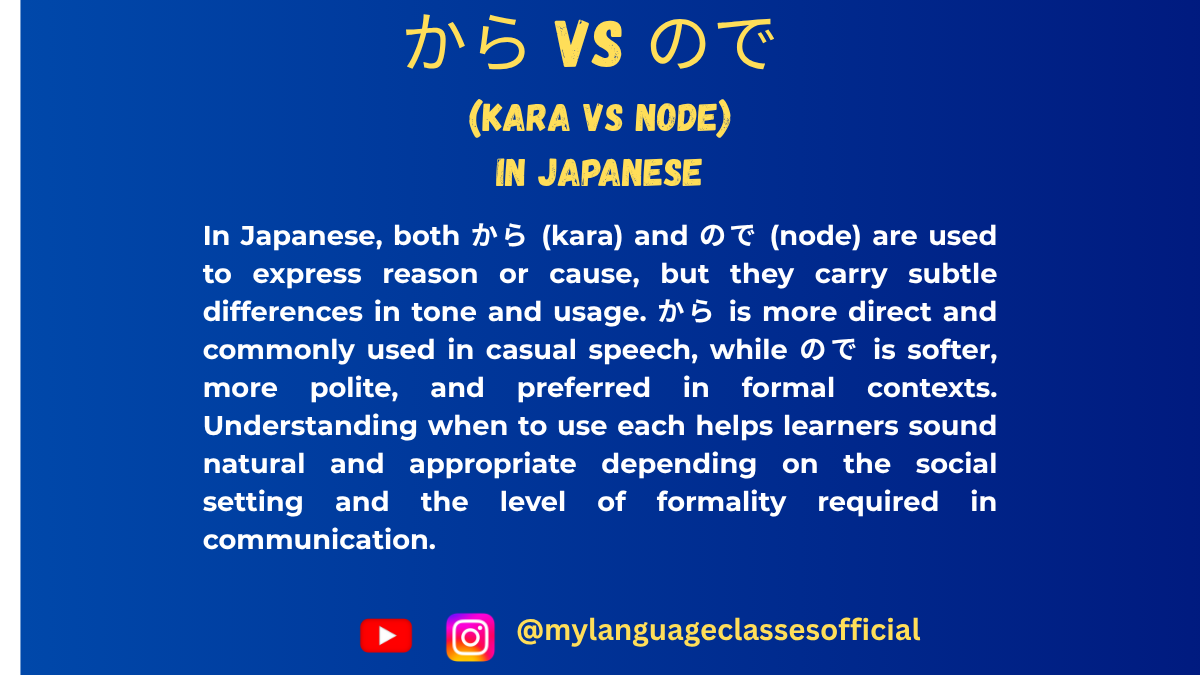
How to Say “Because” in Japanese から (kara) vs. ので (node) | My Language Classes
Expressing “Because” in Japanese: から (kara) vs. ので (node)
When learning Japanese, understanding how to express “because” is essential for forming logical connections in your sentences. Two primary tools for this are から (kara) and ので (node). Both translate roughly to “because” or “since,” but their nuances and appropriate contexts differ. In this post, we’ll explore their meanings, usage, and subtle differences to help you master them.
1. Understanding から (kara)
から is a versatile and commonly used particle to indicate cause and effect. Its usage is straightforward and can be found in both casual and formal contexts, though it often leans more casual.
Structure:
- Reason + から + Result
- Example: 勉強しなかったから、試験に落ちました。
(Benkyou shinakatta kara, shiken ni ochimashita.)
“Because I didn’t study, I failed the exam.”
- Example: 勉強しなかったから、試験に落ちました。
Key Features:
- Direct and Conversational:
から is widely used in everyday speech. It gives a clear and sometimes blunt explanation of reasons.- Example: 雨が降っているから、外に行きません。
(Ame ga futteiru kara, soto ni ikimasen.)
“Because it’s raining, I won’t go outside.”
- Example: 雨が降っているから、外に行きません。
- Flexible Placement:
You can use から in both written and spoken Japanese, though it feels more natural in informal contexts. - Focus on the Speaker’s Perspective:
The reason expressed with から often reflects the speaker’s opinion or justification.
2. Understanding ので (node)
ので is another way to express “because,” but it has a softer, more polite tone. It’s commonly used in formal situations or when you want to sound less direct or imposing.
Structure:
- Reason + ので + Result
- Example: 雨が降っているので、外に行きません。
(Ame ga futteiru node, soto ni ikimasen.)
“Since it’s raining, I won’t go outside.”
- Example: 雨が降っているので、外に行きません。
Key Features:
- Polite and Subtle:
ので carries a sense of consideration, making it ideal for formal or respectful conversations.- Example: お腹が空いたので、何か食べましょう。
(Onaka ga suita node, nanika tabemashou.)
“Since I’m hungry, let’s eat something.”
- Example: お腹が空いたので、何か食べましょう。
- Softer Implications:
Compared to から, ので feels less assertive and more explanatory. It’s often used when the reason is more objective or when you’re asking for understanding. - Common in Formal Writing and Speech:
You’ll frequently see ので in polite correspondence, workplace conversations, and when addressing superiors.
3. Key Differences Between から and ので
Aspect から ので Tone Direct, casual Polite, formal, soft Usage Everyday conversations Formal writing and respectful speech Reason Type Subjective or personal Objective or neutral Politeness Level Casual to neutral Neutral to polite Examples Highlighting the Differences:
- Casual Statement:
- 勉強しなかったから、試験に落ちた。 (Benkyou shinakatta kara, shiken ni ochita.)
“I failed the exam because I didn’t study.” (Direct and casual) - 勉強しなかったので、試験に落ちました。 (Benkyou shinakatta node, shiken ni ochimashita.)
“I failed the exam since I didn’t study.” (Polite and explanatory)
- 勉強しなかったから、試験に落ちた。 (Benkyou shinakatta kara, shiken ni ochita.)
- Polite Request:
- 道が混んでいたから、遅れました。 (Michi ga kondeita kara, okuremashita.)
“I was late because the roads were crowded.” (Blunt explanation) - 道が混んでいたので、遅れました。 (Michi ga kondeita node, okuremashita.)
“I was late since the roads were crowded.” (Polite and considerate)
- 道が混んでいたから、遅れました。 (Michi ga kondeita kara, okuremashita.)
4. When to Use Which?
Use から When:
- Speaking casually with friends or family.
- Explaining personal reasons directly.
- Adding emphasis to the cause-effect relationship.
Use ので When:
- Communicating in formal or polite settings.
- Writing formal letters, essays, or workplace emails.
- Explaining reasons with a softer tone to avoid sounding blunt.
5. A Quick Note on Grammar
- から connects to the plain form of a verb, adjective, or noun:
- Verb: 走るから (Hashiru kara, “Because I run”)
- Adjective: 寒いから (Samui kara, “Because it’s cold”)
- Noun + だ: 先生だから (Sensei da kara, “Because I’m a teacher”)
- ので also connects to the plain form, but nouns and な-adjectives require な before ので:
- Verb: 走るので (Hashiru node, “Since I run”)
- Adjective: 寒いので (Samui node, “Since it’s cold”)
- Noun + な: 先生なので (Sensei na node, “Since I’m a teacher”)
6. Practice Makes Perfect!
Understanding から and ので is only the beginning. Try using them in sentences to express reasons for daily activities. For example:
- 電車が遅れたから、会議に間に合いませんでした。
(Densha ga okureta kara, kaigi ni ma ni aimasendeshita.)
“Because the train was delayed, I couldn’t make it to the meeting.” - 電車が遅れたので、会議に間に合いませんでした。
(Densha ga okureta node, kaigi ni ma ni aimasendeshita.)
“Since the train was delayed, I couldn’t make it to the meeting.”
By practicing these expressions in context, you’ll develop an intuitive sense of when to use から and ので, enhancing both your fluency and sensitivity to Japanese communication styles. Keep practicing, and don’t hesitate to mix them into your conversations!
If you enjoyed this lesson, be sure to check out more posts like this on my blog at My Language Classes. Don’t forget to subscribe my YouTube channel and follow me on Instagram for the latest language learning tips and lessons. Leave a comment below to share your thoughts, or ask any questions you have about nouns.
Happy learning! 😊
- Reason + から + Result
-
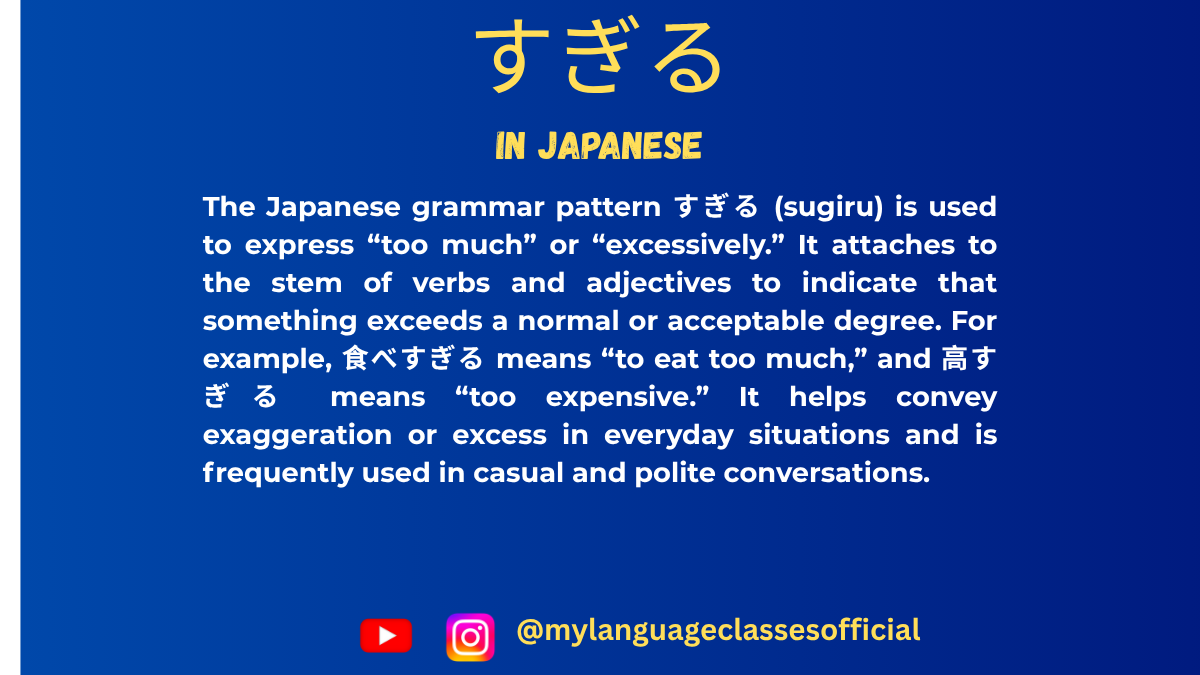
How to Use すぎる in Japanese | My Language Classes
Mastering すぎる: The Key to Expressing Excess in Japanese
When learning Japanese, one of the most versatile tools in your linguistic arsenal is the suffix すぎる (sugiru). This simple yet powerful expression allows you to convey the idea of “too much” or “excessively” with verbs, adjectives, and more. In this blog, we’ll explore how to use it, provide practical examples, and share cultural insights to help you avoid common mistakes.
What Does すぎる Mean?
At its core, すぎる means “to go beyond” or “to exceed.” When attached to the root of a verb or adjective, it transforms the phrase to mean “too much” or “overly.”
For example:- 食べすぎる (tabesugiru): to eat too much.
- 高すぎる (takasugiru): too expensive.
- 使いすぎる (tsukaisugiru): to use too much.
This construction works seamlessly in a wide variety of situations, making it an essential element of everyday conversation.
How to Use すぎる with Verbs
To use すぎる with a verb, follow these steps:
- Take the stem form of the verb (the verb without its final ます in polite form or る in dictionary form).
- Attach すぎる directly to the stem.
Here are some examples:
- 食べる (taberu) → 食べすぎる (tabesugiru): to eat too much.
- 飲む (nomu) → 飲みすぎる (nomisugiru): to drink too much.
- 使う (tsukau) → 使いすぎる (tsukaisugiru): to use too much.
Example sentences:
- 昨日、ラーメンを食べすぎてお腹が痛い。
(Kinō, rāmen o tabesugite onaka ga itai.)
Yesterday, I ate too much ramen, and now my stomach hurts. - 飲み会でお酒を飲みすぎないように気をつけてください。
(Nomikai de osake o nomisuginai yō ni ki o tsukete kudasai.)
Please be careful not to drink too much at the party.
How to Use すぎる with Adjectives
For adjectives, the method depends on whether you’re dealing with an い-adjective or a な-adjective:
1. い-Adjectives
Remove the final い, then add すぎる.
- 高い (takai) → 高すぎる (takasugiru): too expensive.
- 暑い (atsui) → 暑すぎる (atsusugiru): too hot.
Example sentence:
- この服は高すぎて買えない。
(Kono fuku wa takasugite kaenai.)
This clothing is too expensive to buy.
2. な-Adjectives
Simply add すぎる to the base form of the adjective.
- 簡単な (kantanna) → 簡単すぎる (kantansugiru): too simple.
- 静かな (shizukana) → 静かすぎる (shizukasugiru): too quiet.
Example sentence:
- 試験が簡単すぎてびっくりしました。
(Shiken ga kantansugite bikkuri shimashita.)
The test was too easy, and I was surprised.
Nuances and Cultural Tips
- Politeness Matters
In Japanese culture, expressing something as “too much” can sometimes feel blunt. To soften your tone, consider adding phrases like ちょっと (chotto) or using a more indirect expression:
- このラーメン、ちょっと辛すぎると思います。
(Kono rāmen, chotto karasugiru to omoimasu.)
I think this ramen is a little too spicy.
- Avoid Overusing It!
While すぎる is incredibly useful, overusing it can make your speech sound overly critical or negative. Balance it with positive expressions to maintain politeness and harmony in conversations. - Watch for Literal vs. Figurative Use
Sometimes, すぎる is used figuratively:
- 考えすぎる (kangaesugiru): to overthink.
- 頑張りすぎる (ganbarisugiru): to try too hard.
These can reflect emotional or mental states rather than physical actions.
Practice Makes Perfect
To truly master すぎる, try creating your own sentences! Use these prompts:
- What’s something you’ve done “too much” recently?
(食べすぎる, 寝すぎる, 遊びすぎる) - Describe something that felt excessive or overwhelming.
(高すぎる, 静かすぎる, 複雑すぎる)
Conclusion
The すぎる construction is indispensable for describing excess in Japanese. Whether you’re eating too much, overthinking, or facing something outrageously expensive, すぎる lets you express it all with precision and nuance.
So, next time you’re practicing Japanese, try experimenting with すぎる. Not only will it enhance your vocabulary, but it will also deepen your understanding of Japanese culture and conversational dynamics.
Happy learning, and don’t study すぎる (sugiru) much! 😊
If you enjoyed this lesson, be sure to check out more posts like this on my blog at My Language Classes. Don’t forget to subscribe my YouTube channel and follow me on Instagram for the latest language learning tips and lessons. Leave a comment below to share your thoughts, or ask any questions you have about nouns.
Happy learning! 😊
-
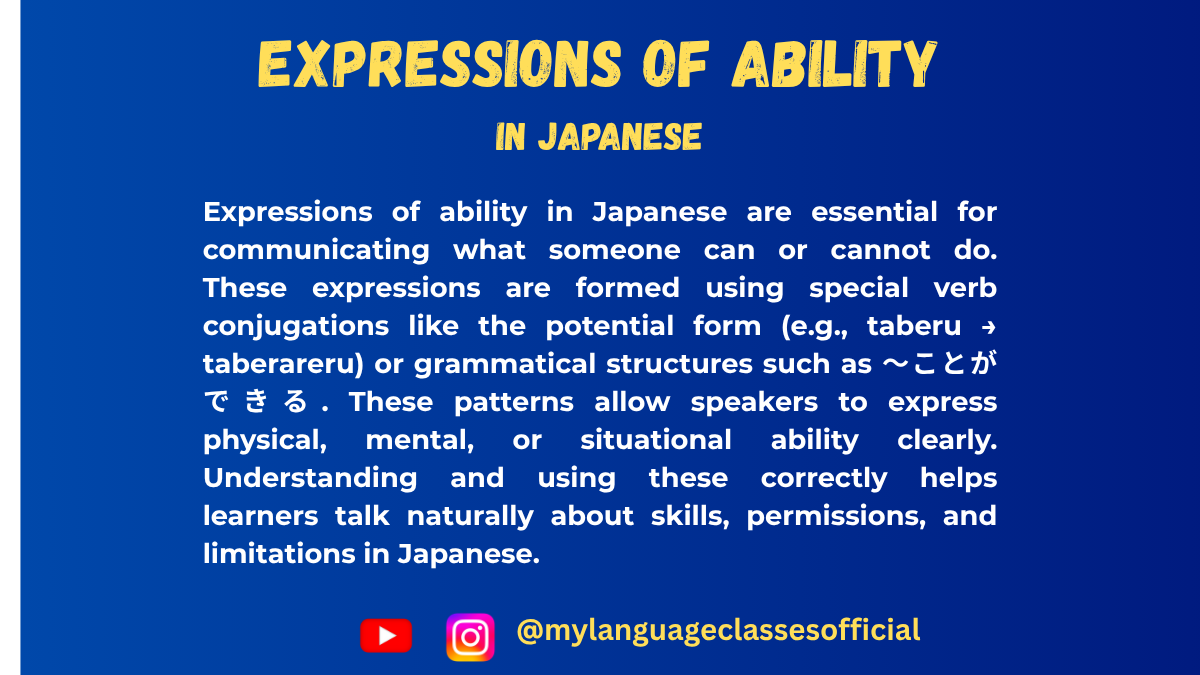
Understanding Ability in Japanese | My Language Classes
Mastering the Expressions of Ability in Japanese
When learning Japanese, expressing ability—your capacity to “do” something—is a crucial skill. In this post, we’ll delve into one of the most common ways to express “can” in Japanese: using ことができる (koto ga dekiru). Along the way, we’ll also explore the potential form of verbs, explaining what it is, how it’s formed, and when to use it. Let’s get started!
Understanding ことができる
The phrase ことができる translates roughly to “can do” or “be able to do.” It’s a versatile structure that allows you to express ability in relation to a wide range of actions. Here’s a breakdown of its components:
- こと: A nominalizer that turns verbs into nouns. For instance, “to speak” (話す, hanasu) becomes “the act of speaking” (話すこと, hanasu koto).
- が: The particle marking the subject of the ability.
- できる: The verb meaning “can do” or “to be able to do.”
Basic Formula:
Verb (Dictionary Form) + ことができる
Examples:
- 日本語を話すことができる
(Nihongo o hanasu koto ga dekiru)
“I can speak Japanese.” - ピアノを弾くことができる
(Piano o hiku koto ga dekiru)
“I can play the piano.” - 友達と旅行することができる
(Tomodachi to ryokou suru koto ga dekiru)
“I can travel with my friends.”
Using できる as a Standalone Verb
Did you notice that できる itself can also stand alone? It translates simply as “can do” and is often paired with a noun:
- テニスができる
(Tenisu ga dekiru)
“I can play tennis.” - 宿題ができる
(Shukudai ga dekiru)
“I can do homework.”
This usage avoids the ことが entirely, but the meaning remains similar.
What is the Potential Form?
The potential form of a verb is another way to express “can” or “ability to do something” in Japanese. Unlike ことができる, the potential form is built directly into the verb itself. It’s widely used in casual speech due to its simplicity and brevity.
When to Use the Potential Form
The potential form is ideal for situations where:
- Informality is key: It’s more conversational than ことができる.
- Directness is preferred: Instead of a multi-word structure, the potential form is compact and to the point.
How to Form the Potential Form
The way you form the potential form depends on the type of verb:
1. Group 1 Verbs (U-verbs)
For U-verbs, change the final -u sound of the dictionary form to its corresponding -eru sound.
Example:
- 話す (hanasu, “to speak”) → 話せる (hanaseru, “can speak”)
- 書く (kaku, “to write”) → 書ける (kakeru, “can write”)
- 泳ぐ (oyogu, “to swim”) → 泳げる (oyogeru, “can swim”)
2. Group 2 Verbs (Ru-verbs)
For Ru-verbs, simply replace the final -ru with -rareru.
Example:
- 食べる (taberu, “to eat”) → 食べられる (taberareru, “can eat”)
- 見る (miru, “to see”) → 見られる (mirareru, “can see”)
3. Irregular Verbs
There are only two irregular verbs to remember:
- する (“to do”) → できる (“can do”)
- 来る (kuru, “to come”) → 来られる (korareru, “can come”)
Examples of the Potential Form:
- 日本語が話せる
(Nihongo ga hanaseru)
“I can speak Japanese.” - ピアノが弾ける
(Piano ga hikeru)
“I can play the piano.” - 友達と旅行できる
(Tomodachi to ryokou dekiru)
“I can travel with my friends.”
Potential Form vs. ことができる
While both methods express ability, they have distinct nuances:
- ことができる: More formal and suitable for writing or polite contexts.
- Example: 日本語を話すことができる
- Potential Form: Shorter and more conversational.
- Example: 日本語が話せる
The Negative Forms
For both ことができる and the potential form, negation is straightforward:
- ことができない: “Cannot do.”
- Example: 日本語を話すことができない
- Potential form (negative): Replace the final -eru or -rareru with -enai or -rarenai.
- Example: 日本語が話せない
Politeness Levels
Japanese offers ways to adjust politeness. Here’s how to modify each form:
- ことができます: Polite version of ことができる.
- Potential Form (Polite): Add -ます to the potential form.
- Example: 話せます (hanasemasu, “can speak”).
Practice Makes Perfect
Let’s end with some practice sentences. Try translating these into Japanese:
- “I can read kanji.”
- “I cannot eat sushi.”
- “I can go to Japan next year.”
(Answers: 1. 漢字を読むことができる / 漢字が読める, 2. 寿司を食べることができない / 寿司が食べられない, 3. 来年日本に行くことができる / 来年日本に行ける)
Final Thoughts
Understanding how to use ことができる and the potential form unlocks a world of possibilities for expressing your abilities in Japanese. Whether you’re aiming for formal precision or casual brevity, practicing these structures will help you sound more natural and confident.
Have questions or want to share your examples? Comment below! 😊
If you enjoyed this lesson, be sure to check out more posts like this on my blog at My Language Classes. Don’t forget to subscribe my YouTube channel and follow me on Instagram for the latest language learning tips and lessons. Leave a comment below to share your thoughts, or ask any questions you have about nouns.
Happy learning! 😊
-
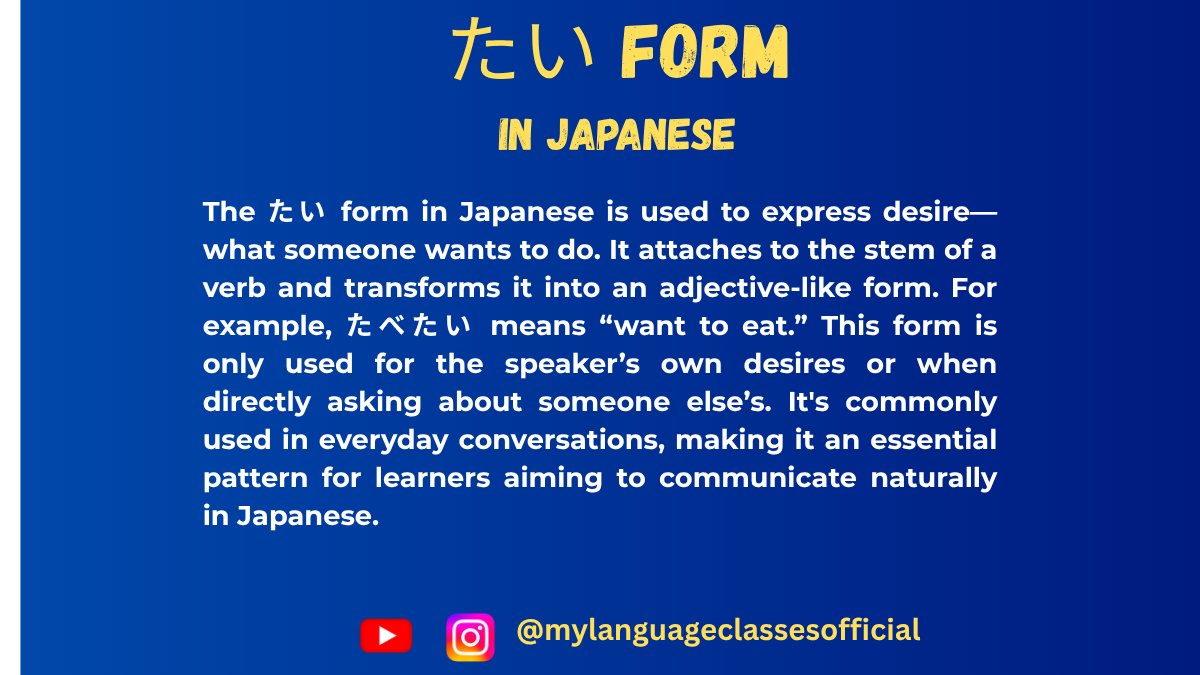
How to Use たい Form in Japanese | My Language Classes
Mastering the Japanese たい Form: A Comprehensive Guide
When learning Japanese, expressing what you want to do is an exciting milestone. The たい form is a versatile and commonly used grammar pattern that helps convey your desires and preferences. Whether you’re talking about your favorite foods, activities, or hobbies, mastering the たい form will greatly enhance your conversational skills. Let’s break it down step by step!
What Is the たい Form?
The たい form is used to express the desire to perform a certain action. In English, this is equivalent to saying, “I want to [do something].” It attaches to the stem of a verb, making it both straightforward and easy to use.
Building the たい Form for All Verb Groups
In Japanese, verbs are categorized into three groups: Group 1 (う-verbs), Group 2 (る-verbs), and Group 3 (Irregular verbs). Let’s dive into how to form the たい form for each group.
Group 1 (う-Verbs)
Group 1 verbs, also known as う-verbs, have dictionary forms that end with an う sound (e.g., 飲む, 読む, 書く).
Steps to form the たい form:
- Remove the final う sound from the verb.
- Replace it with い and add たい.
Examples:
- 飲む (nomu, “to drink”) → 飲みたい (nomitai, “want to drink”)
- 読む (yomu, “to read”) → 読みたい (yomitai, “want to read”)
- 書く (kaku, “to write”) → 書きたい (kakitai, “want to write”)
Negative form:
- Follow the same steps to form the たい structure.
- Replace たい with たくない.
Examples:
- 飲む → 飲みたくない (nomitakunai, “don’t want to drink”)
- 読む → 読みたくない (yomitakunai, “don’t want to read”)
- 書く → 書きたくない (kakitakunai, “don’t want to write”)
Group 2 (る-Verbs)
Group 2 verbs, also known as る-verbs, have dictionary forms that end with る preceded by an い or え sound (e.g., 食べる, 見る).
Steps to form the たい form:
- Drop the る from the verb.
- Add たい to the stem.
Examples:
- 食べる (taberu, “to eat”) → 食べたい (tabetai, “want to eat”)
- 見る (miru, “to see/watch”) → 見たい (mitai, “want to see/watch”)
- 開ける (akeru, “to open”) → 開けたい (aketai, “want to open”)
Negative form:
- Drop the る from the verb.
- Add たくない to the stem.
Examples:
- 食べる → 食べたくない (tabetakunai, “don’t want to eat”)
- 見る → 見たくない (mitakunai, “don’t want to see/watch”)
- 開ける → 開けたくない (aketakunai, “don’t want to open”)
Group 3 (Irregular Verbs)
Group 3, or irregular verbs, includes only two main verbs: する (“to do”) and 来る (“to come”).
Steps to form the たい form:
- する: Replace する with したい.
- 来る: Change to 来たい (きたい, kitai).
Examples:
- する (suru, “to do”) → したい (shitai, “want to do”)
- 来る (kuru, “to come”) → 来たい (kitai, “want to come”)
Negative form:
- する: Replace したい with したくない.
- 来る: Replace 来たい with 来たくない.
Examples:
- する → したくない (shitakunai, “don’t want to do”)
- 来る → 来たくない (kitakunai, “don’t want to come”)
Summary Chart
Verb Type Dictionary Form Stem Positive たい Form Negative たくない Form Group 1 (う) 飲む (nomu) 飲み 飲みたい (nomitai) 飲みたくない (nomitakunai) Group 2 (る) 食べる (taberu) 食べ 食べたい (tabetai) 食べたくない (tabetakunai) Group 3 (Irregular) する (suru) — したい (shitai) したくない (shitakunai) 来る (kuru) — 来たい (kitai) 来たくない (kitakunai) Practice It!
Try converting the following verbs into their たい and たくない forms:
- 書く (kaku, “to write”)
- 遊ぶ (asobu, “to play”)
- 勉強する (benkyou suru, “to study”)
- 起きる (okiru, “to wake up”)
Let us know how you did in the comments!
Polite Forms
The examples above are in casual form, which is great for conversations with friends or family. To make it polite, simply conjugate the たい form with です:
- 食べたい → 食べたいです (tabetai desu, “want to eat”).
- 食べたくない → 食べたくないです (tabetakunai desu, “don’t want to eat”).
Examples:
- 映画を見たいです。
Eiga o mitai desu.
“I want to watch a movie.” - 海に行きたくないです。
Umi ni ikitakunai desu.
“I don’t want to go to the beach.”
Notes on Usage
- First-Person Focus:
The たい form is primarily used to express the speaker’s desires. For example:- 私はケーキを食べたいです。
Watashi wa keeki o tabetai desu.
“I want to eat cake.”
- 私はケーキを食べたいです。
- Context Matters:
Use たい sparingly in formal writing or professional settings. Instead, opt for more polite expressions such as ~たいと思っています (~tai to omotteimasu, “I am thinking I want to…”). - Flexibility in Sentences:
The たい form is flexible and integrates seamlessly into various sentence structures:- 何を食べたいですか?
Nani o tabetai desu ka?
“What do you want to eat?” - 明日は公園に行きたいです。
Ashita wa kouen ni ikitai desu.
“I want to go to the park tomorrow.”
- 何を食べたいですか?
Practice Makes Perfect
Try creating your own sentences with the たい form! Here are some practice prompts:
- What do you want to do this weekend?
- Name three things you don’t want to do.
- Use the たい form in a polite question.
Final Thoughts
The たい form is a valuable tool for expressing your wants and preferences in Japanese. Whether you’re planning your next meal or your next adventure, it helps bring personality and clarity to your conversations. Practice it often, and you’ll find yourself communicating your desires naturally in no time. 頑張って!(Ganbatte! – Good luck!)
What do you want to express in Japanese today? Share in the comments below! 😊
If you enjoyed this lesson, be sure to check out more posts like this on my blog at My Language Classes. Don’t forget to subscribe my YouTube channel and follow me on Instagram for the latest language learning tips and lessons. Leave a comment below to share your thoughts, or ask any questions you have about nouns.
Happy learning! 😊
-

Mastering Question Words in Japanese | My Language Classes
Mastering Japanese Question Words
When learning Japanese, understanding how to ask questions is essential to communication. Whether you’re inquiring about someone’s day or seeking directions in Tokyo, mastering question forms will significantly enhance your confidence. In this blog post, we’ll delve into Japanese question words, how to use them, and the role of か (ka) for forming yes/no questions. Let’s get started!
Essential Japanese Question Words
Japanese question words are key for asking specific questions. Here’s a breakdown of the most common ones:
1. 何 (なに/nani) – “What”
- Examples:
- これは何ですか? (Kore wa nani desu ka?) – What is this?
- 何を食べますか? (Nani o tabemasu ka?) – What will you eat?
The word 何 changes depending on context:
- When followed by ですか (desu ka), it remains nani.
- With particles like を (o) or が (ga), it’s also nani.
- Before な (na)-row sounds, it often becomes なん (nan), e.g., 何時 (なんじ/nanji) – “What time?”
2. 誰 (だれ/dare) – “Who”
- Examples:
- 誰ですか? (Dare desu ka?) – Who is it?
- あなたは誰ですか? (Anata wa dare desu ka?) – Who are you?
For polite speech, you can use どなた (donata) instead of 誰.
3. どこ (doko) – “Where”
- Examples:
- トイレはどこですか? (Toire wa doko desu ka?) – Where is the bathroom?
- あなたはどこに住んでいますか? (Anata wa doko ni sunde imasu ka?) – Where do you live?
4. いつ (itsu) – “When”
- Examples:
- いつ来ますか? (Itsu kimasu ka?) – When will you come?
- 試験はいつですか? (Shiken wa itsu desu ka?) – When is the exam?
5. なぜ (naze) / どうして (doushite) – “Why”
- Examples:
- なぜ行きませんか? (Naze ikimasen ka?) – Why won’t you go?
- どうして泣いているんですか? (Doushite naite irun desu ka?) – Why are you crying?
While なぜ and どうして both mean “why,” どうして is more conversational, whereas なぜ is slightly formal.
6. いくら (ikura) – “How much”
- Examples:
- これはいくらですか? (Kore wa ikura desu ka?) – How much is this?
- 昼ご飯はいくらかかりますか? (Hirugohan wa ikura kakarimasu ka?) – How much does lunch cost?
Forming Yes/No Questions with か (ka)
Japanese yes/no questions are incredibly straightforward—just add か to the end of a sentence. Let’s break it down:
1. Verb + か
- Examples:
- 食べますか? (Tabemasu ka?) – Do you eat? / Will you eat?
- 映画を見ますか? (Eiga o mimasu ka?) – Will you watch the movie?
2. Noun + ですか
- Examples:
- 学生ですか? (Gakusei desu ka?) – Are you a student?
- 日本人ですか? (Nihonjin desu ka?) – Are you Japanese?
Adding か turns a statement into a polite question.
Bonus: Combining Question Words with か
You can combine question words with か to create open-ended questions:
- 何か (nani ka) – “Something”
- 誰か (dare ka) – “Someone”
- どこか (doko ka) – “Somewhere”
For example:
- 何か食べますか? (Nani ka tabemasu ka?) – Will you eat something?
- 誰か来ますか? (Dare ka kimasu ka?) – Will someone come?
Pro Tip for Learners
In informal conversation, か is often omitted:
- これ何? (Kore nani?) – What’s this?
- 誰? (Dare?) – Who?
Practice Makes Perfect
To solidify your understanding, try creating sentences using each question word. For instance:
- Where do you live?
- あなたはどこに住んでいますか? (Anata wa doko ni sunde imasu ka?)
- What will you eat?
- 何を食べますか? (Nani o tabemasu ka?)
Post your examples in the comments for feedback or ask additional questions to enhance your learning. Remember, the key to mastering Japanese question forms is consistent practice!
Happy learning! がんばってください! (Ganbatte kudasai!) 😊
If you enjoyed this lesson, be sure to check out more posts like this on my blog at My Language Classes. Don’t forget to subscribe my YouTube channel and follow me on Instagram for the latest language learning tips and lessons. Leave a comment below to share your thoughts, or ask any questions you have about nouns.
- Examples:
-
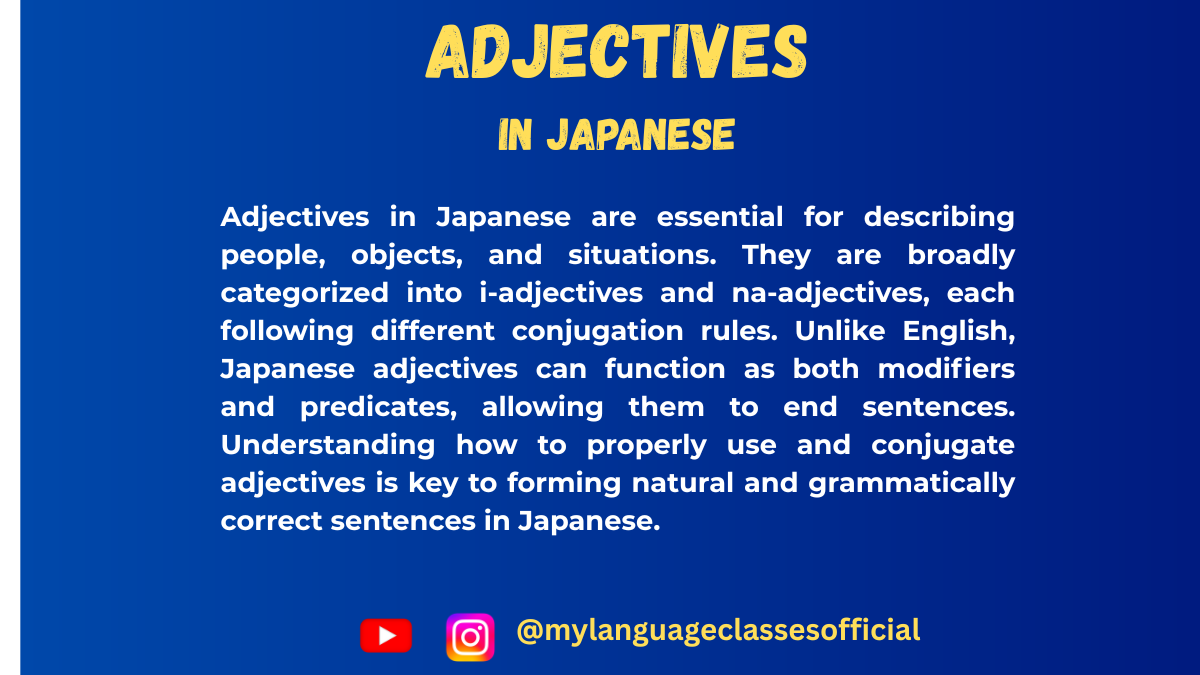
Mastering Adjectives in Japanese | My Language Classes
Mastering Japanese Adjectives: A Comprehensive Guide
When learning Japanese, adjectives play a key role in describing the world around us. They not only add depth to your vocabulary but also enable you to express emotions, describe objects, and narrate experiences with precision. In this blog post, we will dive into i-adjectives and na-adjectives, exploring their various forms to help you master their usage.
Understanding Japanese Adjectives
Japanese adjectives fall into two main categories:
- I-adjectives (い形容詞): These adjectives end with the syllable い, such as 高い (takai, “high/expensive”).
- Na-adjectives (な形容詞): These adjectives are followed by な when modifying a noun, such as 静か (shizuka, “quiet”).
Both types of adjectives can be conjugated to express tense and polarity (affirmative/negative). Let’s break this down with examples!
I-Adjectives: 高い (takai)
I-adjectives are flexible and straightforward to conjugate. Here’s how to handle them:
1. Present Affirmative: 高い (takai)
This is the dictionary form, used to describe something currently high or expensive.
Example: この山は高いです。 (Kono yama wa takai desu. “This mountain is high.”)2. Present Negative: 高くない (takakunai)
Replace the final い with くない to express the negative form.
Example: この家は高くないです。 (Kono ie wa takakunai desu. “This house is not expensive.”)3. Past Affirmative: 高かった (takakatta)
Replace い with かった to describe something that was high or expensive.
Example: 昨日登った山は高かったです。 (Kinō nobotta yama wa takakatta desu. “The mountain we climbed yesterday was high.”)4. Past Negative: 高くなかった (takakunakatta)
Replace い with くなかった to express the past negative.
Example: このカバンは高くなかったです。 (Kono kaban wa takakunakatta desu. “This bag was not expensive.”)Quick Summary Table for I-Adjectives:
Tense Form Example Present Affirmative 高い 高い車 (takai kuruma) – “expensive car” Present Negative 高くない 高くない車 (takakunai kuruma) – “not expensive car” Past Affirmative 高かった 高かった車 (takakatta kuruma) – “was an expensive car” Past Negative 高くなかった 高くなかった車 (takakunakatta kuruma) – “was not an expensive car”
Na-Adjectives: 静か (shizuka)
Na-adjectives require a little different handling, but they are equally systematic. Here’s the breakdown:
1. Present Affirmative: 静か (shizuka)
The base form is used with です to indicate politeness.
Example: この公園は静かです。 (Kono kōen wa shizuka desu. “This park is quiet.”)2. Present Negative: 静かじゃない (shizuka janai)
Add じゃない to the base form to negate it.
Example: この部屋は静かじゃないです。 (Kono heya wa shizuka janai desu. “This room is not quiet.”)3. Past Affirmative: 静かだった (shizuka datta)
Add だった to express that something was quiet.
Example: 昨夜の図書館は静かだったです。 (Sakuya no toshokan wa shizuka datta desu. “The library last night was quiet.”)4. Past Negative: 静かじゃなかった (shizuka janakatta)
Combine じゃなかった to indicate that something was not quiet.
Example: 昨日のカフェは静かじゃなかったです。 (Kinō no kafe wa shizuka janakatta desu. “The café yesterday was not quiet.”)Quick Summary Table for Na-Adjectives:
Tense Form Example Present Affirmative 静か 静かな部屋 (shizuka na heya) – “quiet room” Present Negative 静かじゃない 静かじゃない部屋 (shizuka janai heya) – “not a quiet room” Past Affirmative 静かだった 静かだった部屋 (shizuka datta heya) – “was a quiet room” Past Negative 静かじゃなかった 静かじゃなかった部屋 (shizuka janakatta heya) – “was not a quiet room”
Tips for Mastery
- Practice daily: Use adjectives to describe your environment. For instance, “The sky is blue” → 空が青いです (Sora ga aoi desu).
- Listen to native speakers: Pay attention to how adjectives are used in Japanese media like dramas, anime, or news.
- Create your own sentences: Experiment with mixing different adjectives to make complex sentences.
- Review conjugation patterns: Regularly revisit charts and examples to solidify your understanding.
Conclusion
Mastering Japanese adjectives—both i-adjectives and na-adjectives—is an essential step toward fluency. With consistent practice and a clear understanding of the conjugation rules, you’ll find it easier to describe the world around you. Start using these forms today, and watch your Japanese skills soar!
Happy learning! 頑張ってください! (Ganbatte kudasai!)
If you enjoyed this lesson, be sure to check out more posts like this on my blog at My Language Classes. Don’t forget to subscribe my YouTube channel and follow me on Instagram for the latest language learning tips and lessons. Leave a comment below to share your thoughts, or ask any questions you have about nouns.
Happy learning! 😊
-

Mastering the Te-Form in Japanese | My Language Classes
Mastering the Japanese Te-Form: A Comprehensive Guide
If you’re learning Japanese, one of the most versatile and essential verb forms to master is the te-form. It’s a grammatical powerhouse, allowing you to connect actions, form requests, give commands, and even construct progressive and perfect tenses. Today, let’s dive deep into understanding what the te-form is, why it’s important, and, most importantly, how to form it for all three groups of Japanese verbs.
What Is the Te-Form?
The te-form is a conjugated form of Japanese verbs that ends in て (te) or で (de). It’s named after the final syllable that appears in its conjugation.
Here are the main uses of the te-form:
- Connecting Actions: Link multiple actions in a sentence (e.g., “I woke up, brushed my teeth, and ate breakfast”).
- 朝起きて、歯を磨いて、朝ごはんを食べました。
- Asa okite, ha wo migaite, asagohan wo tabemashita.
- Forming Requests: Politely ask someone to do something.
- ドアを開けてください。
- Doa wo akete kudasai. (Please open the door.)
- Progressive Form: Indicate an ongoing action.
- 今、勉強しています。
- Ima, benkyou shiteimasu. (I’m studying now.)
- Giving Permission or Prohibitions: Say what’s okay or not okay to do.
- 写真を撮ってもいいですか。
- Shashin wo totte mo ii desu ka. (Is it okay to take photos?)
How to Form the Te-Form
To create the te-form, Japanese verbs are categorized into three groups: Group 1 (U-verbs), Group 2 (Ru-verbs), and Group 3 (Irregular verbs). Let’s break down the rules for each group.
Group 1 Verbs (U-Verbs)
Group 1 verbs are the most diverse group. They end in a u sound, such as う, く, す, つ, む, ぶ, ぬ, ぐ, or る (but NOT the same as Group 2 ru-verbs).
Here’s the rule for conjugating these verbs into the te-form:
- Identify the final hiragana of the verb.
- Replace it with its corresponding te/de ending:
Ending in… Change to… Example Te-form う, つ, る って 会う (au, meet) 会って (atte) む, ぶ, ぬ んで 飲む (nomu, drink) 飲んで (nonde) く いて 書く (kaku, write) 書いて (kaite) ぐ いで 泳ぐ (oyogu, swim) 泳いで (oyoide) す して 話す (hanasu, speak) 話して (hanashite)
Group 2 Verbs (Ru-Verbs)
Group 2 verbs are simpler to handle. They end in る, and their stems typically have an i or e vowel sound before る (e.g., 食べる, 見る).
To form the te-form:
- Remove the final る.
- Add て.
Example Verb Te-form 食べる (taberu, eat) 食べて (tabete) 見る (miru, see) 見て (mite)
Group 3 Verbs (Irregular Verbs)
There are only two main irregular verbs, and their te-forms must be memorized.
Verb Te-form する (suru, do) して (shite) 来る (kuru, come) 来て (kite) Another commonly used irregular verb is 行く (iku, go), which is a Group 1 verb but has an exceptional te-form:
- 行く (iku, go) → 行って (itte).
Practice Makes Perfect!
Here’s a quick exercise to check your understanding. Convert the following verbs to their te-forms:
- 飲む (nomu, drink) → __________
- 書く (kaku, write) → __________
- 食べる (taberu, eat) → __________
- 来る (kuru, come) → __________
- 話す (hanasu, speak) → __________
Tips for Remembering the Te-Form
- Group 1 Mnemonic: Think of “tsu, ru, u” as “tte” and “mu, bu, nu” as “nde.” Sing these patterns like a rhythm to memorize them!
- Practice in Context: Use real-life examples to internalize the rules. For example, narrate your daily routine in Japanese using the te-form.
By mastering the te-form, you unlock the ability to express yourself in so many more ways in Japanese. It’s a gateway to conversational fluency and one of the most rewarding aspects of learning the language. So, practice regularly, and soon it’ll feel as natural as saying “ありがとう!”
Got any questions or examples of your own? Share them in the comments!
If you enjoyed this lesson, be sure to check out more posts like this on my blog at My Language Classes. Don’t forget to subscribe my YouTube channel and follow me on Instagram for the latest language learning tips and lessons. Leave a comment below to share your thoughts, or ask any questions you have about nouns.
Happy learning! 😊
- Connecting Actions: Link multiple actions in a sentence (e.g., “I woke up, brushed my teeth, and ate breakfast”).

